The Dark side of the boonie Hat, and its history
Posted by Simon on Jun 3rd 2025
The Dark side of the boonie Hat. The boonie hat, introduced during the Vietnam War, was initially met with resistance from some commanders who felt it looked unprofessional and did not meet their standards for military dress. The US military initially had mixed reactions to the boonie hat. While troops in the field appreciated its comfort and protection from the sun and elements, top brass often viewed it as unprofessional due to its floppy design.
Despite the disapproval of some superiors, troops in the field found the boonie hat to be comfortable, practical, and useful for protection against the sun and other weather conditions.
Also its design is so practical you can folded in half or in four and store it in a pocket.
Even if last year in 2024 the boonie Hat was made part of the official in most US government Military agency, you can see by reading this great article https://www.military.com/daily-news/2024/08/16/request-denied-no-boonie-hats-airmen-nevada-base-general-says.html
Some High official in some base still refuse it.
From the battlefield to the fashion runway, headwear has shaped identity and utility alike. While Caroline Reboux sculpted elegance in felt for 19th-century Paris, and Coco Chanel stripped away the excess in the 1920s, it was the rough-edged practicality of the boonie hat that crowned soldiers like Captain Criss in the unforgiving jungles of Southeast Asia.
And so this bring to the:
THE BOONIE HAT STORY
Also known as a booney hat, jungle hat, bush hat, field hat, combat hat, military sun hat, or bucket hat, the boonie hat is a wide-brim tactical hat often referred to as a safari hat, sniper hat, operator hat, or even a Rambo hat, depending on the region and use case.
The boonie hat's origins can be traced to the Vietnam War, where U.S. Army Green Berets and other units began using them. While the modern boonie evolved during this period, its design likely draws inspiration from earlier British and Australian bush hats and also French fashion, which were used in hot climates before the Vietnam War.
Here's a more detailed look:
- Pre-Vietnam War Influence:
The boonie's design may have been influenced by earlier British bush hats and Australian giggle hats, which were also used in hot and humid environments.
During the Vietnam War, U.S. military Allies, the Australians were already there with their bush hats. Some Vietnamese people also wore large, dark boonie-style hats, which I suspect were influenced by the French during their period in Vietnam. There was also the Mle-49 ‘Le Chapeau de Brousse’ — a famous and very hard-to-find French bush hat, used by the French Foreign Legion during their conflicts in Vietnam and the Algerian theaters of operation.
Vietnam War Development:
During the Vietnam War, the U.S. Army officially adopted the boonie hat in 1967, which was referred to as "hat, jungle, with insect net". Units like the 5th Special Forces Group, along with Australian and ARVN units, began wearing them in the field.
Colloquial Term:
The name "boonie" is believed to have originated from the term "boondocks," which was used to refer to remote or wilderness areas.
A boonie hat or booney hat is a type of wide-brim sun hat commonly used by military forces in hot tropical climates. Its design is similar to a bucket hat but with a stiffer brim.[1]
The Australian giggle hat has a thinner brim. Often a fabric tape band of "branch loops" is sewn around the crown of the hat. This "foliage ring" is meant to hold additional vegetation as camouflage. A strap provides stability. The crown may be vented with eyelets or small mesh panels. Snaps may also be provided with which to fix the brim in the style of an Australian bush hat.
U.S. military boonie hat
A blue cap with an all-around brim was issued as part of the 1937 blue denim fatigue uniform that was nicknamed the "Daisy Mae hat".[2][3][self-published source?] The M1941 green herringbone twill cloth fatigue uniform featured the same hat. The military caps inspired "Johnny Jeep" hats (or "Johnny Jeepers") which were featured on the cover of the August 24, 1942 issue of LIFE magazine and mocked in the accompanying article. The cover features two female models wearing the hats in style, while the article notes that the fashion accessory costs $25 at John-Frederic's (from a famous milliner known as Mr. John) and the "Army hat" costs 45¢. Photos of GIs demonstrating various ways to wear the hat are included in the tongue-in-cheek article. Lord & Taylor produced licensed copies for a reduced price; cheap knockoffs ("bootleg imitations") soon followed.[4]
The boonie hat was introduced to the United States Armed Forces during the Vietnam War, when U.S. Army Green Berets of the 5th Special Forces Group began wearing them in the field, along with Australian and Army of the Republic of Vietnam units.[5] These leopard spots or tigerstripe boonie hats were locally procured, and the camouflage cloth was usually salvaged from other uniform items or parachutes, and were fabricated by a tailor in the style of the French chapeau de brousse Mle 1949. The name is derived from "boonie", the abbreviated form of boondocks (originally American military slang derived from Tagalog bundok, "mountain", during the Philippine–American War).[6][7][8][9] The hat was similar to the hat worn with the pattern 1941 HBT fatigue uniform.
In 1967, the U.S. Army began issuing boonie hats, such as the "Hat, Jungle, with Insect Net", made of cotton and wind-resistant poplin, in olive drab, tigerstripe, and ERDL pattern.[10] It was meant to supplement and replace the patrol and baseball caps that had been in service since World War II. As the U.S. military evolved away from a garrison mentality, the boonie hat found a permanent place as part of the uniform of all services. The boonie hat has changed little through the decades since the Vietnam War and was used in both the Iraq War and the War in Afghanistan as an alternative to the patrol cap. The U.S. military boonie hat has come in a variety of camouflage patterns; the current assortment includes Woodland, three-color desert, UCP, MultiCam, and both desert and woodland versions of MARPAT, as well as the Air Force ABU pattern.[5] The boonie hat is often worn with the wearer's rank insignia pinned or sewn to the front, above the branch loops.
So the Hat, Camouflage (Tropical Combat) Type II was created.
1949- MLE-49 FRENCH INDOCHINA & ALGERIA BUSH HAT
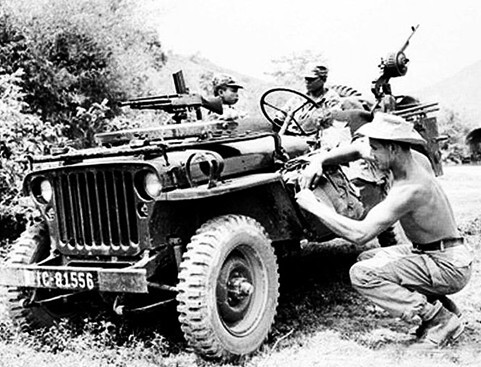
Figure 1-Between 1949 and 1954, most likely around 1950–1953 — when the Mle 49 hat had entered regular use and the conflict in Indochina had intensified.
Mle-49 ‘Le Chapeau de Brousse’ Famous and very hard to find, French ‘bush hat’ as used by the French Foreign Legion during their conflicts in Vietnam and Algerian theaters of operation. We have a small number of new manufactured Mle-49 hats in the almost impossible to find size of U.S. size 7-1/2" (Large)!!! We also have some in 7-1/4". There are faithfully made in a heavy khaki cotton with traditional batting in the brim ( not cardboard !).
2 grommets on each side with brim snap on one side.
Because of the difficulty and labor intensive sewing pattern that encompassed the entire hat to make it durable to the standards of the Legion, we had to work with a number of manufacturers before we found one who could get it right! You’ll love this hat on the farm, camping, travelling etc! We like it because it is truly a bush hat that looks ‘hard core adventurer’, and not commercial traveler. The type you’d wear all year round in Panama or Alaska!
1953
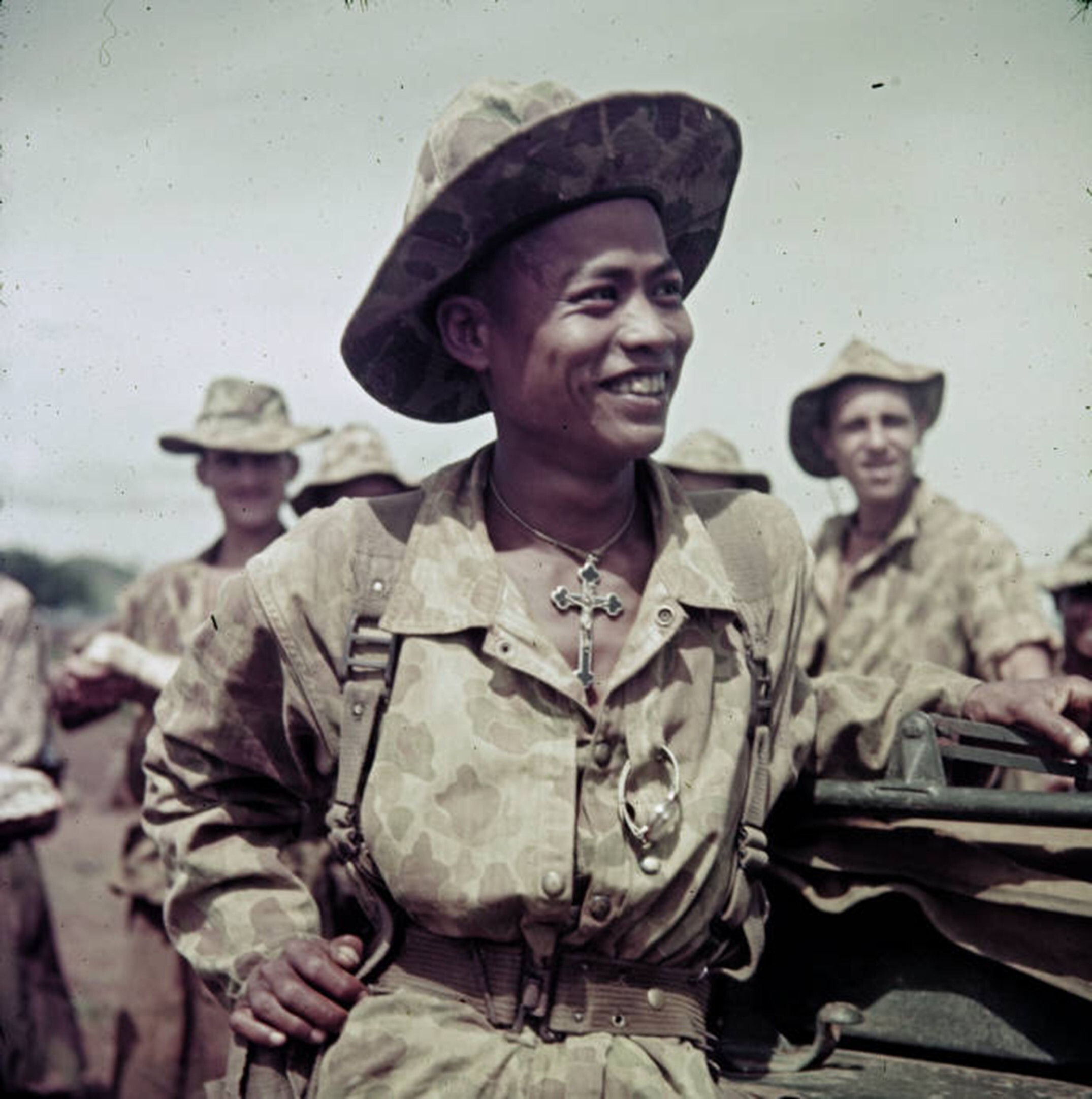
|
Title |
Vietnam, Vietnamese soldier serving in First Indochina War at Na Sản military camp |
|
Date of Photograph |
1953 |
|
Photographer's Note |
Vietnam - Indo-China - Catholic Vietnamese with French forces fighting communists in Indo-China. |
|
Photographer |
https://collections.lib.uwm.edu/digital/collection/agsphoto/id/53038/ |
|
Description |
An agreement between Ho Chi Minh and the French (1946) made Vietnam a free state though fighting between parties erupted into the First Indochina War ending in May 1954. |
In 1968 the U.S. Army authorized the use of the woodland ERDL pattern (Engineer Research & Development Laboratory) material, used in 1969 and later production of hats in cotton ripstop material. These were labeled, "Hat, Camouflage (Tropical Combat) Type II" with contract dates starting in 1968. They were in use from 1968 for both the Army and Air Force, and from 1969 to 1970 for the Marine Corps and Navy.[5]
Hat, Sun, Hot Weather
Later boonies are called "Hat, Sun" or "Hat, Sun, Hot Weather", which is still the designation for this type of cover. They are made in various patterns, in cotton ripstop or nylon blend cloth.[5]
Australian Army giggle hat
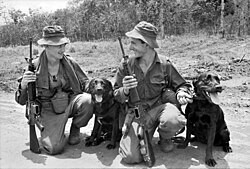
Figure 1-1967–1971 is the most accurate window for this picture.
Two Australian soldiers wearing "giggle hats" in South Vietnam
Similar wide-brimmed hats in the Australian Army are known as giggle hats although today most Australian soldiers refer to them as bush hats, unlike in the past where a slouch hat with the brim down was referred to as a bush hat. Along with slouch hats, giggle hats were issued as the standard uniform of Australian troops fighting in the South West Pacific theatre, during the Second World War. The design apparently originated from an earlier British uniform intended for fighting in hot and humid conditions. They were nicknamed "giggle hats" (as well as "hat ridiculous-for-the-use-of") by the Australian troops due to their appearance.[11]
The giggle hat gained popularity during the Malayan Emergency. Protection from the searing heat of Malayan conditions and heavy rain proved to be necessary. Alongside the British, the Australian Army started issuing this type of hat, which had a steeper and shorter brim than its earlier counterparts. It was made with the same materials as the hot weather combat uniforms, unlike the slouch hat, which was beginning to take on a more ceremonial role rather than being field gear.
These hats gained popularity during the Vietnam War, where they were called 'hats utility, jungle green', although they were colloquially known by Australians as giggle hats. Their New Zealand counterparts referred to them as "J hats." During this conflict, most Australian soldiers were issued the hat. The army created several regulations: the hat was not allowed to be modified or cut whatsoever, and it had to be worn when outdoors at all times. The hat had also served to break up the recognizable outline of the soldier's head. It was made with cotton twill and was issued in olive drab, the standard colour of Australian combat uniforms at the time.
 U.S. Army issue boonie hat in the BDU camouflage pattern, circa 1994
U.S. Army issue boonie hat in the BDU camouflage pattern, circa 1994
A boonie hat or booney hat is a type of wide-brim sun hat commonly used by military forces in hot tropical climates. Its design is similar to a bucket hat but with a stiffer brim.
The Australian giggle hat has a thinner brim. Often a fabric tape band of "branch loops" is sewn around the crown of the hat. This "foliage ring" is meant to hold additional vegetation as camouflage. A strap provides stability. The crown may be vented with eyelets or small mesh panels. Snaps may also be provided with which to fix the brim in the style of an Australian bush hat.
T wo U.S. military servicemen wearing boonie hats in 2001
wo U.S. military servicemen wearing boonie hats in 2001
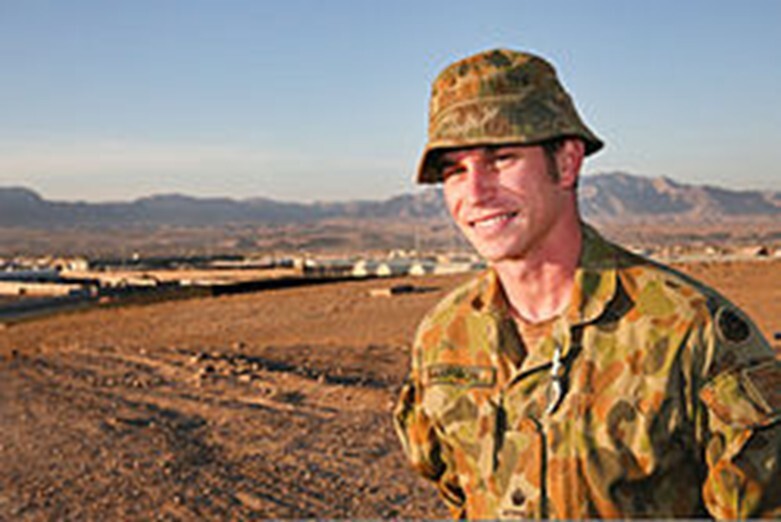 Australian soldier wearing a giggle hat, Afghanistan, 2013
Australian soldier wearing a giggle hat, Afghanistan, 2013
Current giggle hats are issued in Multicam Pattern. They continue to be heavily used by the Australian Defence Force, and are issued to every person serving in the Australian Army and Royal Australian Air Force (RAAF).
See also
Bucket hat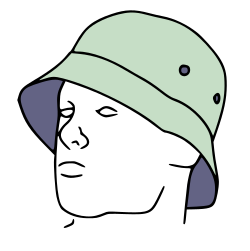
A bucket hat (variations of which include the fisherman's hat, Irish country hat and session hat) is a hat with a narrow, downward-sloping brim. Typically, the hat is made from heavy-duty cotton fabric such as denim or canvas, or heavy wool such as tweed, sometimes with metal eyelets placed on the crown of the hat for ventilation.
It was first adopted as a high fashion item in the 1960s, and with subsequent revivals in both street fashion and on the catwalk. It is popular festival gear in the present day, also known as a "session hat".
sponge, and it could be reshaped using steam from a kettle.[2] In the 1960s, it was often worn by members of the Mod subculture.[1]
The modern bucket hat is derived from a tropical hat made from olive drab cotton that was issued to the US Army during the Vietnam War. These lightweight hats became popular among civilians for use in sports such as fishing, and as sun protection.[3]
|
Related Resources |
Harrison Forman Diary, Cambodia, April 1953 accessible at https://collections.lib.uwm.edu/digital/collection/forman/id/65/rec/1 |
In fiction:
and was notably worn by Sean Connery's character in Indiana Jones and the Last Crusade 1989. Depic Sean Connery hat, Indiana Jones Last Crusade, Henry Jones Sr fedora, vintage grey fedora, 1930s professor hat, Herbert Johnson fedora, Lock & Co hat, classic men’s felt fedora, explorer style hat, movie costume hat.
 Captain Price (John price) Fictional video game caracter if call of duty appearing in in Call of Duty 4: Modern Warfare as Captain of the 22nd SAS Regiment in (2007 the actual game itself) Captain Price give a boost the popularity of the Boonie hat and people will find trick to form the boonie hat to ressemble Pirce’s Hat form.
Captain Price (John price) Fictional video game caracter if call of duty appearing in in Call of Duty 4: Modern Warfare as Captain of the 22nd SAS Regiment in (2007 the actual game itself) Captain Price give a boost the popularity of the Boonie hat and people will find trick to form the boonie hat to ressemble Pirce’s Hat form.
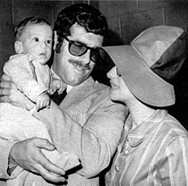 Barbra Streisand – with Elliott Gould and son Jason Gould – wearing a fashionable oversized bucket hat in 1967
Barbra Streisand – with Elliott Gould and son Jason Gould – wearing a fashionable oversized bucket hat in 1967
In the 1960s, the bucket hat was adapted as a ladies' fashion item, in common with the pillbox, bakerboy, and cloche styles, suiting the fashion for more bouffant hair.[4] Milliners such as Lilly Daché created designs in felt or other stiffer fabrics to capture the "mod" look.[5] The older tweed Irish walking hat remained popular among professional men until the 1970s.
The hat became popular with rappers in the 1980s and remained part of street fashion into the 1990s. In the 2010's, it has re-emerged as a fashion catwalk item after being sported by celebrities such as Rihanna.[7] Since then, luxury bucket hats have been produced by brands such as Gucci, Loewe, and Prada.[8] The bucket-hat has also been associated with the hip-hop scene. The trend was set-off by LL Cool J and Run-DMC, and since then many musical sensations have used it.[9]
World Regional names and variations
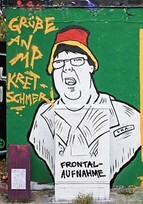 Graffiti of the "Hutbürger" in Dresden (2018)
Graffiti of the "Hutbürger" in Dresden (2018)
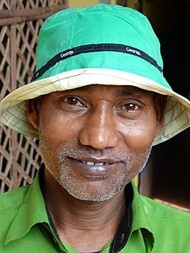 A Bengali man wearing a bucket hat
A Bengali man wearing a bucket hat
- In Bulgaria it is popular as "idiotka" (Bulgarian: идиотка), which means "idiot hat".[10]
- In Australia the version worn by the Australian Defence Force is referred as a "Giggle Hat".[11]
- In Israel, it is known as a tembel hat or "Rafael hat", after Rafael Eitan, an Israeli general, politician, and former Chief of Staff of the Israel Defense Forces, who used to wear one. A similar type of hat called a tembel hat is dubbed the national hat of Israel as it was worn by Israeli Halutzim to protect from sunburn.
- In Sweden, it is known as a "Beppehatt" or "Beppemössa", since Beppe Wolgers, a Swedish author and artist, used to wear it and made it popular in the 1970s.
- In Denmark, it is known as "bøllehat" (troublemaker hat) since the 1880s, when a group of young delinquents would gather every Sunday in Bøllemosen in Jægersborg Dyrehave, from where they made trips to a popular dance restaurant in Charlottenlund to steal the ladies' hats.
- In Argentina, it is known as "sombrero Piluso" (Piluso hat), after Alberto Olmedo's character, where its popularity rose after the 2022 FIFA World Cup.
- In Russia, it is called "panama" (Russian: панама). The name came from misconception of panama hat, known as hat of Ecuadorian workers in Panama.
- In South Africa, it is known as an "ispoti" and is very popular with urban black youth, representing being streetwise without copying foreign hip-hop trends.[citation needed]
- In Tanzania, it is very popular among elders, especially among the Iraqw people.
- In the US, a similar hat is used officially by the US Navy for enlisted service dress uniforms, commonly referred to as a Dixie Cup hat, as in the manufacturer brand of paper cups.[citation needed]
- In France, it is called a "Bob [fr]".[12]
- In Germany, it is called "Anglerhut" (fisher's hat). It is popular as an accessory in German hip hop.[13] In 2018, a right-wing protester wearing a bucket hat in the colors of the Flag of Germany became notorious as a "Hutbürger" ("hat citizen"),[14] a play on words of "Wutbürger" or "enraged citizen".
- In the UK, it is sometimes called "Reni hat", after Stone Roses drummer Reni who frequently wore the hat.[15][16]
- In Italy, it's called a "fisherman's hat" (cappello da pescatore).[17]
- In Brazil and Mexico, it's widely known as "chapéu do Seu Madruga"[18] (Don Ramón's hat) and respected[19] due to being worn by the character. Cosplayers may be casually seen in some cities wearing the iconic hat.[20]
- In the Netherlands, it's referred to as a vissershoed.[21]
In popular culture
 IKEA branded bucket hats at an IKEA store in Emeryville, California in 2022.
IKEA branded bucket hats at an IKEA store in Emeryville, California in 2022.
- Both fictional characters Inspector Clouseau from The Pink Panther film series and Detective Lieutenant Louie Provenza of the television series The Closer and Major Crimes frequently wear bucket hats: for Peter Sellers' portrayal of Clouseau, a grayish-shade Irish tweed fabric variety, with Provenza wearing a white bucket hat while at crime scenes.[22][23][24][25]
- Female sleuths wear them too. Dame Margaret Rutherford wore bucket hats from her own wardrobe when she starred as Miss Jane Marple in four films, beginning with Murder She Said in 1961. Brenda Blethyn also wears bucket hats in her role as Detective Chief Inspector Vera Stanhope in ITV crime drama Vera (TV series) from 2011 to 2025.
- Don Ramón (played by Ramón Valdés) always don his signature blue bucket hat in Mexican sitcom El Chavo del Ocho.
- The character Gilligan in the TV series Gilligan's Island ubiquitously wears a cream-colored bucket hat throughout its episodes.
- During the 1990s Liam Gallagher, lead vocalist of the rock band Oasis, was photographed multiple times wearing a bucket hat.[26]
See also
The bucket hat is said to have been introduced around 1900.[1] Originally made from wool felt or tweed cloth, these hats were traditionally worn by Irish farmers and fishermen as protection from the rain, because the lanolin from the unwashed (raw) wool made these hats naturally waterproof.[2] From the interwar years onwards, these "Irish walking hats" were quickly adopted internationally for country pursuits because, when folded, they could fit inside a coat pocket. If the hat fell in the mud, it could be easily cleaned with a damp
 Cloche hat as worn by silent film star Vilma Bánky, 1927
Cloche hat as worn by silent film star Vilma Bánky, 1927
The cloche hat or simply cloche (pronunciationⓘ) is a fitted, bell-shaped hat for women that was invented in 1908 by milliner Caroline Reboux.[1] They were especially popular from about 1922 to 1933.[2] Its name is derived from cloche, the French word for "bell".[3]
And here the legendary Coco Chanel, in the 1910s playing golf. With a familiar design
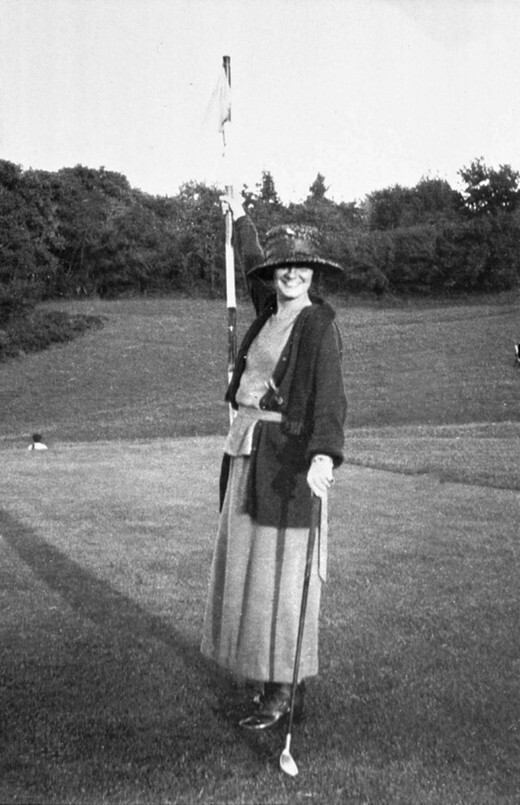
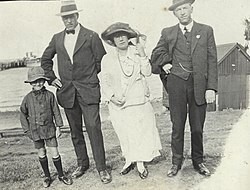 Australian boy wearing tweed bucket hat, 1917
Australian boy wearing tweed bucket hat, 1917
And here Coco Chanel wearing a similar design in 1924,
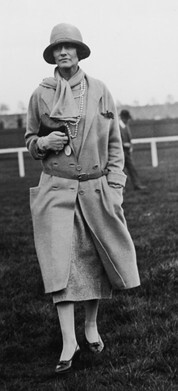
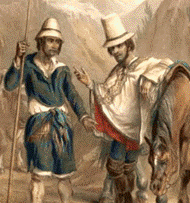 We can see here the form was common in different design in the past resemblning the modern Boonie hat. Hats as an indicator of social status: a foreman (with horse) wears a hat of greater height than the accompanying inquilino (1821 Chile).
We can see here the form was common in different design in the past resemblning the modern Boonie hat. Hats as an indicator of social status: a foreman (with horse) wears a hat of greater height than the accompanying inquilino (1821 Chile).
References
- ^ "The History Of Boonie Hats In The U.S. Military". USAMM. 11 March 2022.
- ^ p. 11 Young, Edward M. Merrill’s Marauders Osprey Publishing Ltd. 2009
- ^ . p. 81 Lemons, Charles Uniforms of the U.S. Army Ground Forces 1939 – 1945 Volume 5 Part 1 Caps and Hats Lulu.com, 13 May 2016[self-published source]
- ^ "The Johnny Jeep Hat: The Army fatigue hat inspires a new fashion fad". Life. 24 August 1942. pp. 104–105. Retrieved 29 June 2018.
- ^ Jump up to:a b c d Hat, Jungle (Boonie)
- ^ Tom Dalzell (2008). The Routledge Dictionary of Modern American Slang and Unconventional English. Routledge. p. 110. ISBN 978-1-134-19478-0.
- ^ Clay, Grady (1998). "Boondocks". Real Places. Chicago: University of Chicago Press. pp. 180–181. ISBN 0-226-10949-6.
- ^ Kramer, Paul (2006). The Blood of Government. Chapel Hill: University of North Carolina Press. pp. 33–34. ISBN 0-8078-5653-3.
- ^ Heller, Louis (1984). "boondocks". The Private Lives of English Words. London: Routledge & Kegan Paul. p. 20. ISBN 0-7102-0006-4.
- ^ "Vietnam - Equipment and Uniform". david.brubakers.us.
- ^ Cyril Ray (2001). "Jungle Chic". Australian Government Department of Veterans' Affairs. Retrieved November 13, 2014.
- MLE-49 French Indochina & Algeria Bush Hat - SARCO, Inc


 hudson boonie hat collection
hudson boonie hat collection